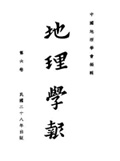H. Y. HU
The Province Kiangsu is one of the most prosperous agricultural regions of China. It yield 8.5% of rice, 12.5% of wheat, 20% of cotton, 16% of cocoon produced in the whole country.The province may be divided into four agricultural regions according to their predominate products:1. The northern region where wheat, kaoliang, maize, and millet are prod-uced.2. The central rice region,3. The southern rice and sericulture region, and4. The coastal cotton region.
